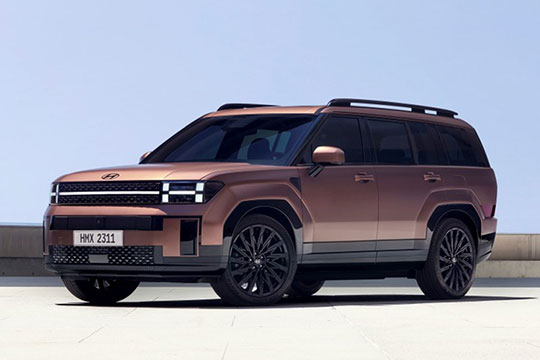Body style: SUV (Sports Utility Vehicle)
Segment: Medium SUV
Infotainment: ![]() Apple CarPlay
Apple CarPlay ![]() Android Auto
Android Auto
Production years: 2023, 2024
 14 Photos
14 PhotosHyundai shook the world in 2023 when it introduced the fifth generation of its Santa Fe SUV, surprising its competitors with a bold-looking vehicle that was completely different than its predecessors. Moreover, not only that it was a larger vehicle, but it was more luxurious and garnished with all the bells and whistles that an upscale car could offer. Still, it wasn't considered a premium SUV but a mass-market one. One that could've been used on a daily urban commute and on weekends for a camping trip.
Hyundai was eager to introduce the fifth generation of the Santa Fe. The Korean automaker sent the previous generation to retirement after just five years, which was uncommon for the car's segment. But seeing the new model, it was quite understandable. The fifth Santa Fe offered a demanding look on the road, featuring a flat front fascia. Its headlights were dispersed in an unusual pattern and connected by a light strip that crossed the car's main grille from side to side. Gone were the rounded, soft shapes of its predecessor. The 2024 Santa Fe featured straight cuts for the lower side intakes and the lower grille. Moreover, from its profile, the SUV boasted flared wheel arches that created the impression of a rugged off-road vehicle. To make the car look more dynamic, the designers made a slightly descending roof line, and the last two pillars were almost vertical. But while the front and the sides of the vehicle looked very bold, the rear fascia didn't impress too much due to its lower light panel that crossed the tailgate. The proportions between the glass area and the metallic panels were not that much pleasant. But it was a form that followed function, and for that, Hyundai had to be forgiven.
Inside, the almost vertical side panels and the long cabin offered plenty of room for those who loved camping in nature and didn't want to sleep in a tent. The Santa Fe was available with two or three rows of seats, and by folding all but the first ones, it created a completely flat surface where at least two people could sleep in comfort. For daily use, though, the automaker prepared a well-equipped dashboard with a digital instrument cluster for the driver and a 12.3" touchscreen placed atop the center stack for the infotainment system. These two formed a panoramic curved display with a seamless integration behind the same piece of glass. Fortunately, the main audio controls and the HVAC unit kept their physical buttons in place.
Under the hood, Hyundai installed a choice of two hybrid drivetrains powered by either a 1.6-liter or a 2.5-liter gasoline unit. Both were carried over from the previous generation of the Santa Fe.
HYUNDAI Santa Fe 2023, 2024
Information about this model's engines has not been yet made public, but we will add it as soon as the car is launched or more data becomes available













